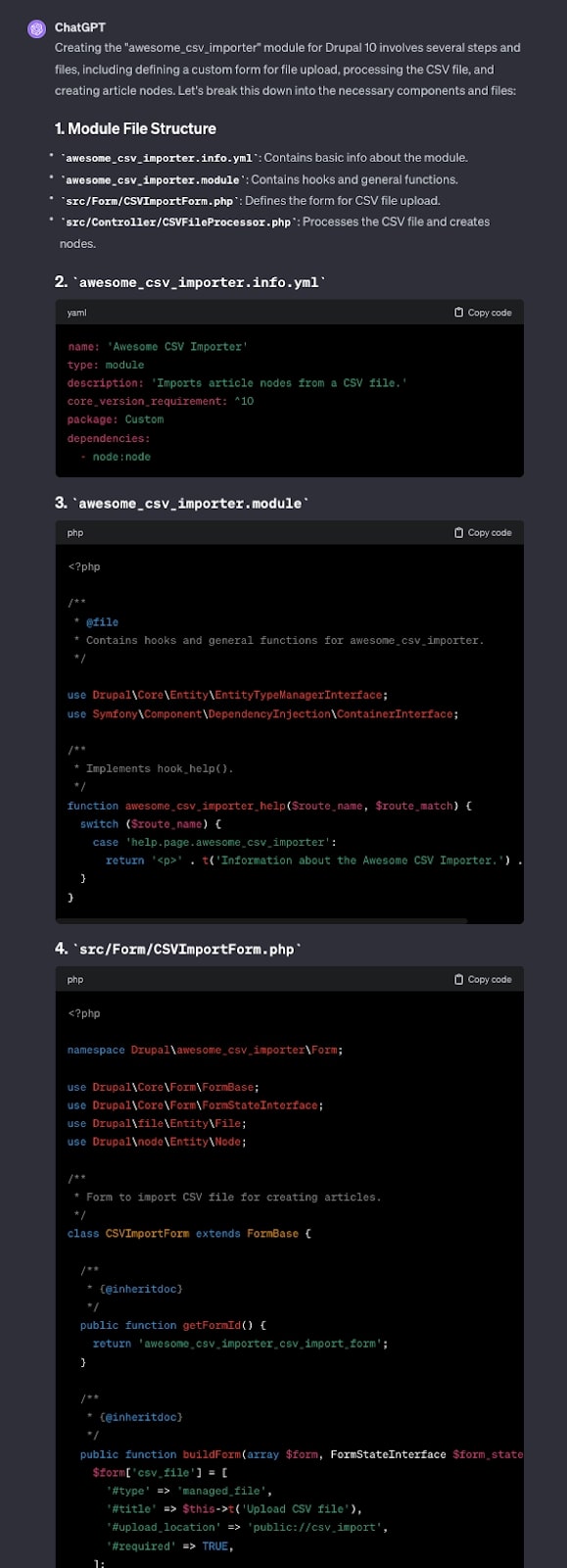AI-Powered Custom Drupal Module Development: A Step-by-Step Tutorial

Table of Contents
Takeaway: Using AI tools like ChatGPT can dramatically streamline custom Drupal module development, enabling even those with limited coding experience to create functional modules. While AI assistance significantly accelerates the development process, developers should understand current limitations. Despite existing challenges, AI-assisted Drupal development represents a powerful new approach that's transforming how we build custom modules.
SEE WHAT AI SOLUTIONS WE OFFER
2023 appears to be the year that Artificial Intelligence emerged from the shadows and into the mainstream, but the potential of AI has barely scratched the surface. AI is here, and its impact on life and work is developing at an exponential pace.
As this disruptive technology is generating quick answers, streamlining processes, and creating vast new efficiencies, hundreds of possibilities for AI—ranging from healthcare diagnoses to cybersecurity threat detection, government services, and most relevantly, custom Drupal module development—are taking shape.
This post will explore how an AI large language model (LLM) such as ChatGPT can be used for writing code—specifically, creating custom Drupal modules from scratch.
Getting started with an LLM: Prompt engineering for Drupal development
An LLM is essentially a massive, simulated brain trained on an even more massive amount of data.
LLMs such as ChatGPT are extremely good at identifying the "next best word" in a conversation to the point where humanlike intelligence emerges.
Interacting with an LLM is done conversationally, beginning with a "prompt." Think of this process as writing a software program, with conversational English being the programming language.
The first step in leveraging an LLM for Drupal module development is to give it context. Even if the context of what is being asked appears obvious, stating it explicitly can increase the quality of the code that is returned.
For the purpose of generating code for a custom module, a good example of a starting prompt could begin with: "You are an expert Drupal 10 developer..." Since the answer is built one word at a time, an explicit prompt such as this helps to create a framework for success.
What is the "Chain-of-Thought" technique in AI for Drupal development?
Another technique called "Chain-of-Thought" can help increase the quality of an AI response. The idea is to list out the steps the AI should take when thinking about a solution. This is similar to writing a software program, except communication is at a higher level of abstraction.
For example, rather than writing a prompt that reads: "As an expert chef, please give me an apple pie recipe," the Chain-of-Thought technique would provide deeper, step-by-step instructions such as:
"As an expert chef, please think about different, popular apple pie recipes, specifically looking at the crust and the filling. Identify the best aspects of the different recipes. Consider how they could be combined to make an even better recipe. Finally, generate a final recipe."
For more complex custom Drupal modules, the Chain-of-Thought technique can be broken into multiple steps in a dialogue with an AI tool such as ChatGPT.
Refining the prompt
Because an LLM can act as a natural language program interpreter, giving it rules to follow will help it to better achieve the right results. Here’s an example of writing a prompt for the purpose of helping in writing prompts:
"You are an expert Prompt Engineer. Your goal is to craft the best possible prompt to be used by ChatGPT. Please follow the process below:"
- "Your first response will be to ask me what the prompt should be about. I will provide my answer, but we will need to improve it through continual iterations by going through the next steps."
- "Based on my input, you will generate two sections: a) Revised prompt (provide your rewritten prompt. It should be clear, concise, and easily understood by you), and b) Ask any relevant questions pertaining to what additional information is needed from me to improve the prompt."
- "We will continue this iterative process with me providing additional information to you, and you refining the original prompt in the 'Revised prompt' section until I decide this process is complete."
- "Do not actually process the prompt once it is ready. That will be done in a separate conversation."
AI for custom Drupal module creation
Now that we've covered various aspects of Prompt Engineering, let's look at using LLM prompts for code generation. Here are some tips:
- Generate fully completed code. If the solution you're generating is relatively straightforward, it may be easier to ask the AI to generate fully completed code rather than using placeholder comments. GPT-4 tends to use placeholders, which may or may not be helpful depending on the task at hand.
- Let it know that it is okay to generate a long response. Your prompt could read something like: "It is okay if your response stops abruptly; I will say 'continue.'"
- Be sure to give it context at the beginning, such as: "You are an expert Drupal 10 developer."
- Use the Chain-of-Thought to help guide it. By "holding its hand" and providing more detailed steps, the result is more likely to work correctly.
Sample Chain-of-Thought prompt for creating a Drupal module
Here's a complete example prompt for creating a custom CSV importer module:
You are an expert Drupal 10 developer.
You will be writing a module called "awesome_csv_importer"
This module will provide a form where a CSV file can be uploaded. This CSV file will contain data for creating article nodes. Each row will contain a "title" and "body" field.
The author for each node should be user 1.
Before proceeding, think about Drupal best practices for this CSV import.
If there is an issue, an error should be output as a Drupal message.
For each file in this module, please note the file's path within the module.
Please generate a fully completed code; do not use placeholder comments.
Please be sure to properly comment on your code, following Drupal code standards.
It is okay if your response stops abruptly. "I will say 'continue.'"
Here's a screenshot of the beginning of the GPT-4's response to this prompt:

After the initial code is generated, there is often an iterative process as issues are identified by reviewing or running the code, and then the AI tool is asked to make corrections. If errors are encountered, it is sufficient to just paste the error into a follow-up message.
For more complex solutions, it may be more appropriate to generate sub-sections of the module via different conversations rather than using a single conversation to generate the whole module.
Limitations of AI for Drupal development
While AI offers tremendous potential for streamlining custom Drupal module development, several important limitations currently exist that developers should be aware of:
- Input size constraints: AI models have limits on how much code they can process at once. When conversations get too long, the AI must compress previous exchanges, potentially losing important context about your Drupal module requirements or code specifics.
- Hallucinations and inaccurate solutions: AI can sometimes "hallucinate"—generating code that references non-existent Drupal hooks, methods, or functions that seem plausible but don't actually exist in the Drupal codebase.
- Version compatibility issues: AI might suggest solutions appropriate for older Drupal versions (like Drupal 7 or 8) when you're working on Drupal 10. This requires constant vigilance and explicit reminders about which version you're targeting.
- Poor judgment in implementation: While AI can generate technically functional code, it may not follow Drupal best practices or offer scalable, future-proof solutions. The AI might choose suboptimal approaches that a human expert would avoid.
- Security considerations: When using cloud-based AI services, you're sharing your code with third-party systems. This raises potential security concerns for sensitive projects, though this is less problematic for open-source Drupal module development.
Despite these limitations, AI capabilities are improving rapidly. Future versions will likely offer increased context windows, better judgment, and reduced hallucinations. Organizations that learn to effectively integrate AI into their Drupal development workflows now will be well-positioned for the increasingly AI-assisted future of web development.
For a comprehensive analysis of these limitations and insights on how AI is evolving in Drupal development, read my full blog post: "Will AI Replace Web Developers? Five Hurdles to AI-Driven Drupal Development."
Prompting for the big picture: AI for Drupal module development
The above represents real-world walkthroughs and recent experiences for leveraging an LLM to develop a Drupal module. There’s much more. As another demonstration of the instant insights and information that ChatGPT can provide, I recently entered a ChatGPT prompt that read:
Can AI be leveraged to develop a module in Drupal?
Here's the answer that resulted from this prompt:

Yes, AI can be leveraged to develop modules in Drupal. Drupal is an open-source content management system (CMS) that allows developers to create and customize websites. AI technologies can be integrated into Drupal modules to enhance various aspects of a website, such as personalization, content recommendation, natural language processing, and more.
Here are some ways AI can be incorporated into Drupal modules:
Content Personalization:
- Use AI algorithms to analyze user behavior and preferences.
- Develop a Drupal module that dynamically displays personalized content based on user preferences, improving user engagement.
Chatbots and Conversational Interfaces:
- Integrate AI-powered chatbots or conversational interfaces within Drupal websites.
- Create a module that allows users to interact with the website using natural language, providing a more user-friendly experience.
Search Optimization:
- Implement AI-driven search algorithms to improve the accuracy and relevance of search results.
- Develop a Drupal module that integrates advanced search capabilities powered by AI.
- Image and Video Recognition:
- Utilize AI for image and video recognition within Drupal.
- Create modules that automatically tag and categorize media content based on AI analysis.
Data Analytics and Reporting:
- Integrate AI for data analytics to extract meaningful insights from user interactions and website performance.
- Develop Drupal modules that provide detailed analytics and reporting using AI algorithms.
Security Enhancements:
- Implement AI-driven security measures to identify and prevent potential threats.
- Develop modules that use AI to enhance website security by detecting and responding to malicious activities.
Automated Content Generation:
- Use natural language processing (NLP) algorithms to automatically generate content.
- Develop Drupal modules that assist in creating and optimizing content based on AI-generated suggestions.
When integrating AI into Drupal modules, it's important to consider factors such as data privacy, performance, and the specific requirements of the website. Additionally, leveraging existing AI libraries and frameworks can simplify the development process.
Drupal's modular architecture makes it well-suited for incorporating AI functionalities into various aspects of a website.
Explore AI for custom Drupal module development with Promet Source
As amazing and disruptive as today's LLMs are, they are only going to become faster and more capable as research continues. It is hard to predict the rate at which LLM solutions will evolve because there may be unexpected bottlenecks; it may be that the availability of computational resources will be the main limiting factor for how smart these LLMs can become.
However, it is safe to say that current and upcoming AI solutions will disrupt many aspects of Drupal development, perhaps even more than the Internet did in the 1990s. In the same way that media companies evolved to leverage the Internet, AI will drive a similar evolution in how we approach custom module development in Drupal.
While the future is not clearly mapped out, the time to embrace AI for Drupal module development is now.
Interested in architecting AI-powered solutions for your Drupal website? Promet is at the leading edge of exploring the potential and possibilities of AI for custom Drupal module development.
Get our newsletter
Get weekly Drupal and AI technology advancement news, pro tips, ideas, insights, and more.




